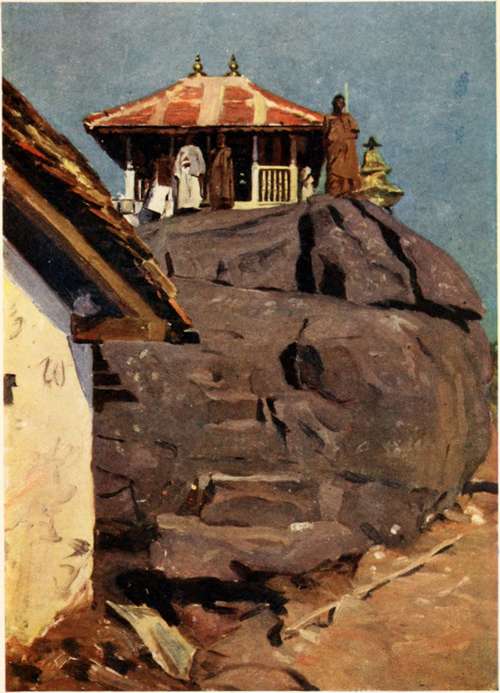Chapter XIV. Adam's Peak
Description
This section is from the book "Ceylon", by Alfred Clark. Also available from Amazon: Ceylon.
Chapter XIV. Adam's Peak
The best known, but not the loftiest, mountain in Ceylon is Adam's Peak. It stands in solitary grandeur, seven thousand two hundred and sixty feet high, on the western edge of the great central plateau, and is visible to voyagers approaching Ceylon miles out at sea.
It has been a place of pilgrimage for a score of centuries to the devout of many races and several creeds. On its summit is a great boulder, on the top of which is a depression, about four feet long, which, with the aid of chisel and mortar, has been made to resemble roughly a gigantic human footprint. The Singhalese, Siamese, Burmese, and Tibetans claim it to be that of Buddha, the Great Teacher, and call it the Sri Pada. All the Hindu races of India assert it to be that of Siva, the god who, in the form of the divine hero Rama, invaded Ceylon to recover his abducted wife Sita from the demon-king. The Mohammedans proclaim it to be that of Adam, who, they say, after being driven out of Paradise, stood on one foot on the Peak for centuries by way of penance ! There are even so-called Christians who believe it to be that of St. Thomas, who is reported to have visited the Indies. Consequently, there is a never ending stream of pilgrims from all parts of the East to this famous shrine.
There are two ways of ascending the Peak. One, and by far the more laborious, is straight up from the low-country. The path is a mere narrow track, worn by millions of feet in past centuries, through dense forest, up torrent-beds, and along the edges of precipices. The last few hundred feet are so precipitous that chains have been fixed in many places for safety, and panting pilgrims, pausing to take breath, may see the clouds drifting beneath them. Should a weary pilgrim ask people descending the mountain how far it is to the summit, he will not be told the actual distance, but that it is " the trouble " of so many miles !
The other way is from Hatton, a little hill-town through which the railway passes. A good road, some fourteen miles in length, leads nearly to the foot of the sugar-loaf Peak, passing through what, fifty years ago, was a vast forest called "The Wilderness of the Peak".

Adam's Peak.
There are legends connected with every stream, ravine, and rock in the pilgrim-path. A long straight crack in a great flat-topped rock is said to have been made by Buddha with the point of his needle, as he sat mending his robes, as an indication to some demons who showed themselves that they were not to approach any nearer!
A tiny chapel has been built over the sacred footprint. It belongs to the Buddhists, who appropriate all the offerings, whether made by worshippers of their own faith or Hindus or Mohammedans. The pilgrims usually come up in family parties, and on arrival make the circuit of the shrine, chanting their prayers and shouting "Sadhu!" an expression of joy. As they pass the bell which hangs near the door, every man, woman and child strikes it, in order to draw the attention of the guardian spirits. They then make their offerings, which usually consist of flowers and money.
A strange phenomenon may often be observed from the summit on a clear, cloudless morning. As soon as the sun rises, a blue transparent pyramidal shape is visible on the sky to the west. It is the shadow of the Peak, thrown on the thin mist rising from the low-country. This gradually sinks as the sun rises, and disappears in about twelve minutes. Soon after the shadow appears again, clearly defined on the country below, and before long it will be noticed that there are two shadows, that of the cone-shaped Peak overlying the shadow of the whole mountain range.
Continue to:
